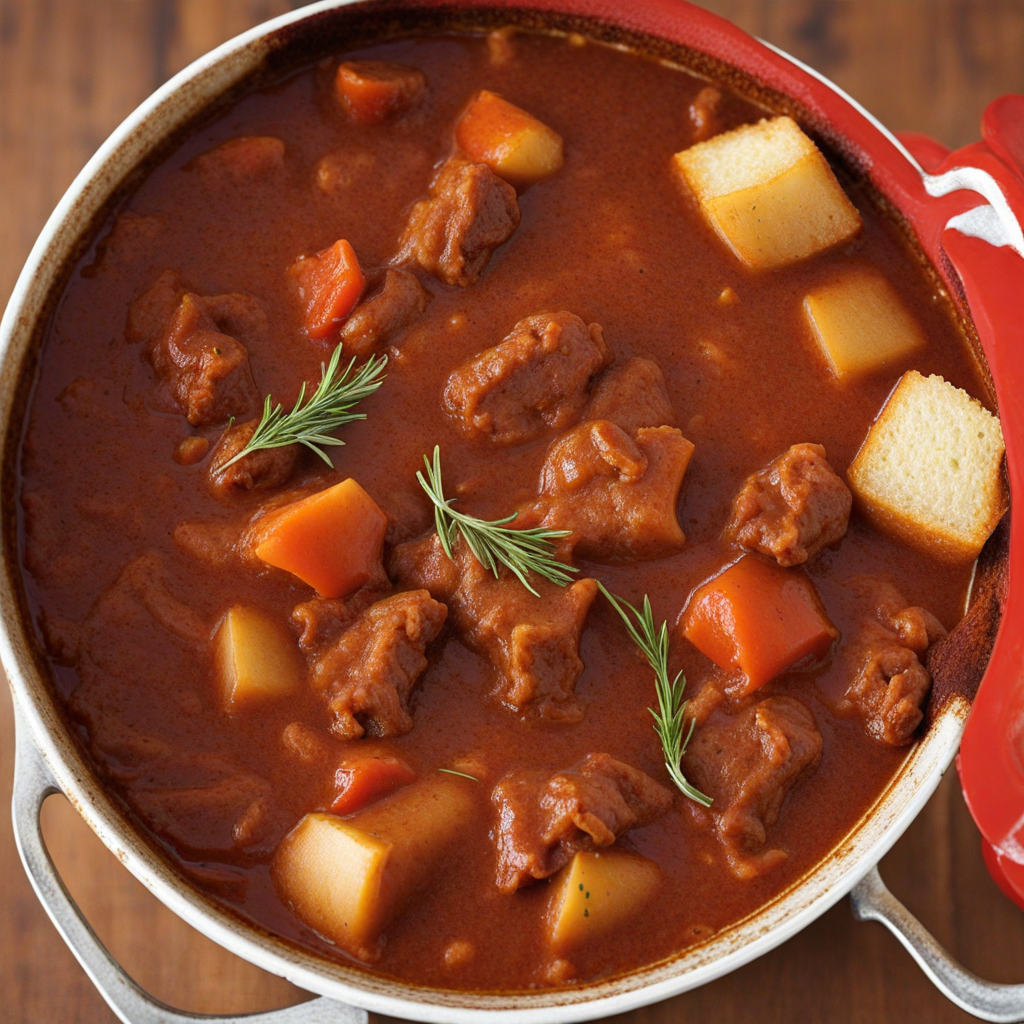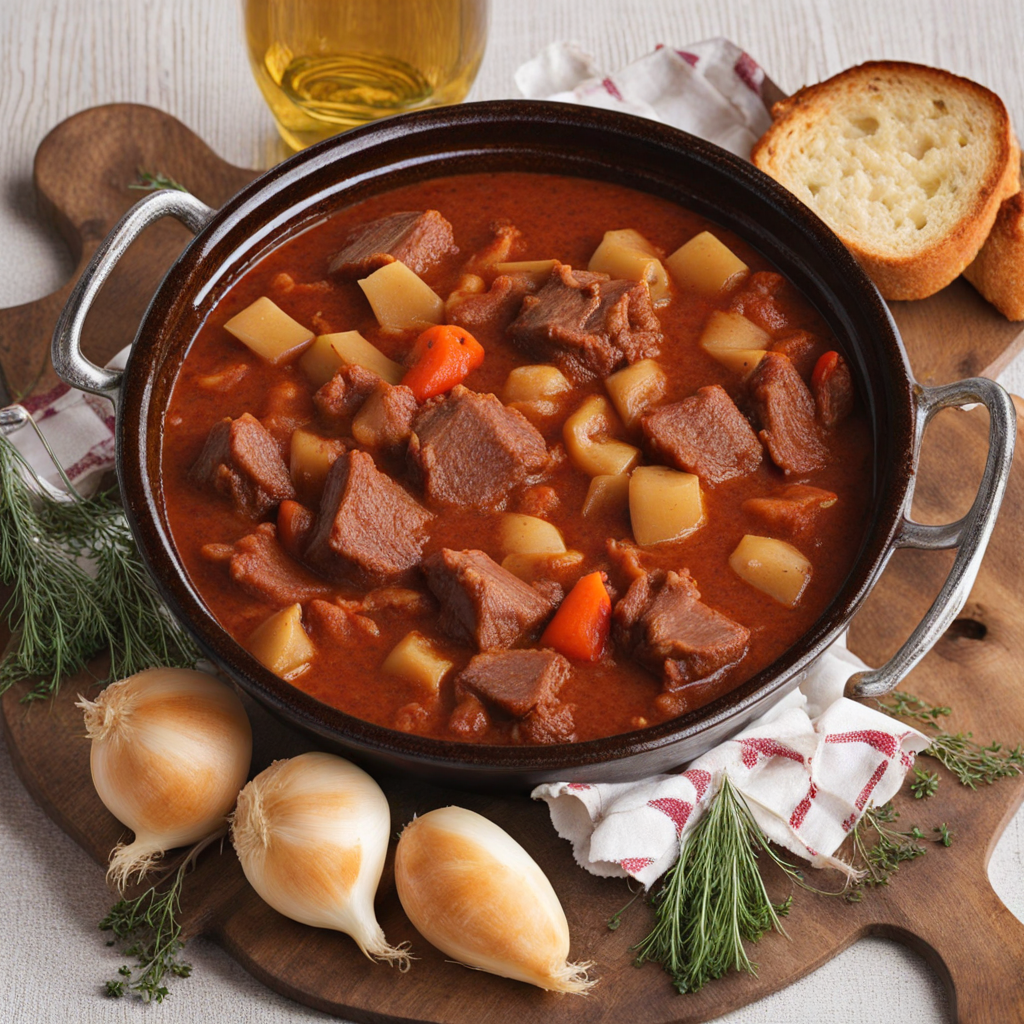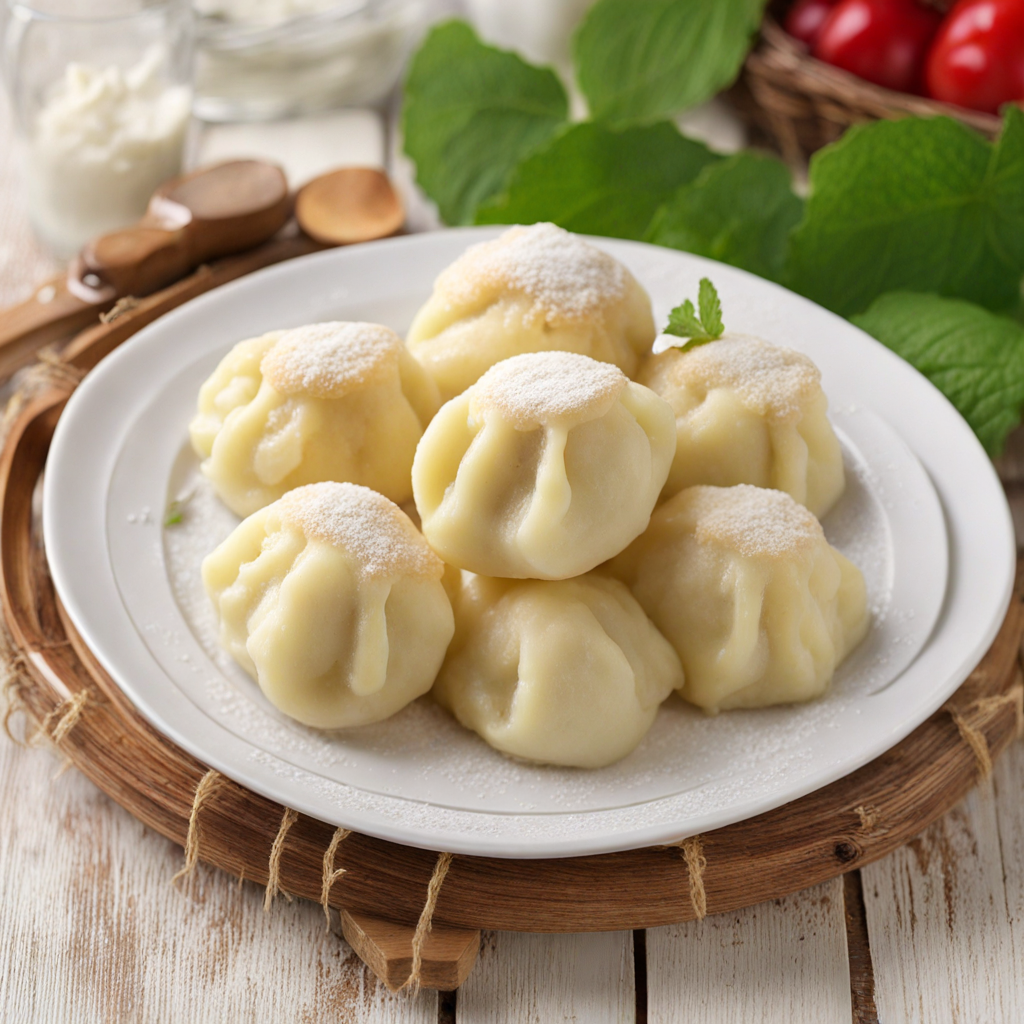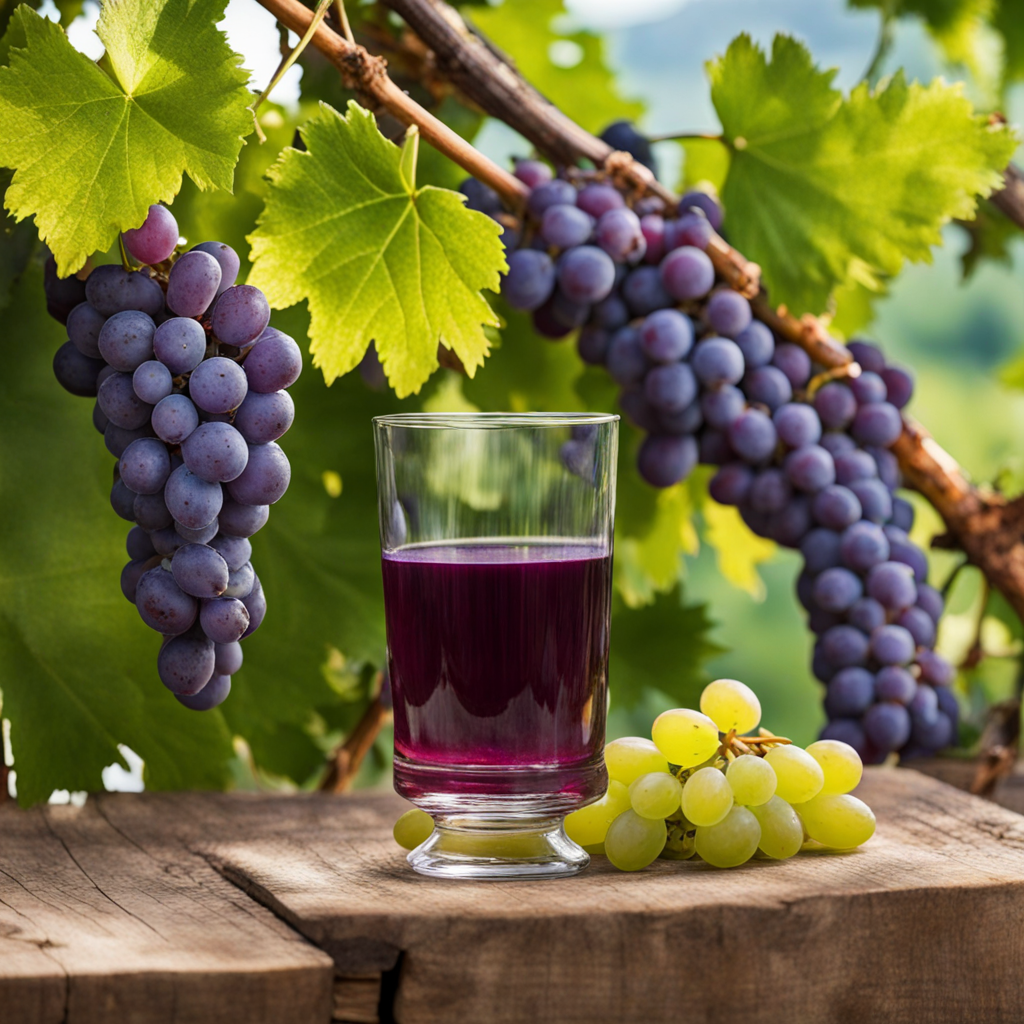Slovenian Goulash
Slovenian Goulash, known locally as "gulaš," is a hearty and flavorful dish that showcases the rich culinary traditions of Slovenia. This comforting stew typically features tender chunks of beef or pork, simmered slowly with onions, garlic, and a blend of aromatic spices. The key to its distinctive flavor lies in the use of sweet paprika, which not only imparts a beautiful color but also adds a warm, slightly smoky depth. Each bite offers a delightful balance of savory and slightly spicy notes, making it a perfect dish for chilly evenings or gatherings with family and friends. The preparation of Slovenian Goulash often involves a careful layering of flavors, starting with sautéing the onions until they are golden and sweet. As the meat is added, it browns nicely, sealing in the juices before being enveloped in a rich broth flavored with tomatoes and herbs like bay leaves and marjoram. Some variations may include additional vegetables such as carrots or potatoes, which absorb the delicious sauce and contribute to the dish’s heartiness. The result is a warm, comforting stew that is both satisfying and nourishing. Traditionally served with a side of fresh bread or dumplings, Slovenian Goulash is more than just a meal; it’s a celebration of the country’s agricultural bounty and cultural heritage. Whether enjoyed at a rustic mountain inn or made at home, this dish invites you to experience the warmth of Slovenian hospitality. Each bowl of goulash tells a story of tradition and connection, making it a must-try for anyone eager to explore the diverse flavors of Eastern European cuisine.
How It Became This Dish
Slovenski Golaž: A Culinary Journey Through Slovenia's Cultural Landscape Slovenia, a picturesque country nestled between the Alps and the Adriatic Sea, boasts a rich tapestry of culinary traditions that reflect its diverse cultural heritage. Among the many dishes that define Slovenian cuisine, Slovenski golaž stands out as a beloved and hearty stew that embodies the spirit of Slovenian hospitality and communal dining. This essay delves into the origins, cultural significance, and evolution of Slovenski golaž, illustrating its importance in the Slovenian culinary landscape. Origins of Slovenski Golaž The roots of Slovenski golaž can be traced back to the 19th century, influenced by the Austro-Hungarian Empire's culinary practices. Golaž, which is derived from the Hungarian "gulyás," originally referred to a shepherd's stew made with meat and vegetables, traditionally prepared by cattle herders in the Hungarian plains. The dish was characterized by its simple ingredients, which were easily accessible to farmers and shepherds: meat, potatoes, onions, and paprika. As the Austro-Hungarian Empire expanded, so did the culinary exchanges among its diverse populations. Slovenians adopted and adapted this hearty stew to suit their local ingredients and tastes. The use of beef as the primary meat became prevalent, but variations may include pork or game, particularly in rural areas where hunting was common. The addition of local vegetables, such as carrots, parsnips, and bell peppers, further distinguished Slovenski golaž from its Hungarian counterpart. Cultural Significance Slovenski golaž is more than just a dish; it is a symbol of Slovenian culture and community. It is often prepared for family gatherings, celebrations, and communal events, serving as a bridge between generations and a means of fostering connections. The act of cooking and sharing a pot of golaž creates an atmosphere of warmth and togetherness, reinforcing social bonds that are integral to Slovenian life. In Slovenia, food is a vital part of cultural identity, and Slovenski golaž holds a prominent place in this narrative. It represents the simplicity and resourcefulness of Slovenian cooking, where the emphasis is placed on using fresh, seasonal ingredients. The dish is often associated with the slower pace of rural life, where meals are prepared with care and shared with loved ones, reflecting the Slovenian values of hospitality and generosity. Additionally, Slovenski golaž has been embraced as a national dish, celebrated during various culinary festivals and events throughout the country. It is commonly served in homes, restaurants, and at food fairs, where chefs showcase their unique interpretations of the classic recipe. This celebration of golaž highlights Slovenia's pride in its culinary heritage and the importance of food as a cultural expression. Development Over Time Over the decades, Slovenski golaž has undergone various transformations, influenced by regional ingredients, culinary trends, and the growing interest in Slovenia's gastronomic identity. While traditional recipes remain cherished, contemporary interpretations have emerged, showcasing the creativity and innovation of Slovenian chefs. One significant development in the preparation of Slovenski golaž is the shift towards using locally sourced ingredients. With the rise of the farm-to-table movement and a growing awareness of sustainable practices, many cooks are returning to traditional farming methods and emphasizing the use of organic and locally sourced produce. This shift not only enhances the flavor and quality of the dish but also supports local farmers and reinforces the connection between food and the land. Moreover, the globalization of culinary practices has introduced new flavors and techniques to traditional recipes. Modern chefs may experiment with spices, herbs, and cooking methods, creating unique versions of Slovenski golaž that reflect a fusion of influences. For instance, some may incorporate international ingredients like cumin or cilantro, while others explore vegetarian or vegan adaptations, showcasing the versatility of the dish. Despite these innovations, the essence of Slovenski golaž remains intact. The core elements of meat, vegetables, and spices continue to define the dish, serving as a canvas for culinary creativity while honoring its roots. The balance between tradition and modernity in Slovenski golaž exemplifies Slovenia's evolving culinary landscape, where the past is celebrated and reimagined in contemporary contexts. Regional Variations Slovenski golaž is not a monolithic dish; rather, it varies significantly across different regions of Slovenia. Each area brings its own local ingredients, culinary customs, and interpretations to the stew. In northern Slovenia, for instance, cooks may use game meat, like venison, to create a richer flavor profile, while in the coastal regions, fish may be incorporated, reflecting the Mediterranean influence. In the Prekmurje region, known for its fertile plains, golaž may be prepared with abundant root vegetables and served alongside traditional bread, which is essential for soaking up the flavorful broth. Conversely, in the mountainous regions, the dish might feature heartier ingredients, such as smoked meats and wild mushrooms, reflecting the rugged landscape and the availability of local produce. These regional variations not only highlight the diversity of Slovenski golaž but also illustrate the interconnectedness of Slovenian cuisine with its geography and cultural practices. Each variation tells a story of the land, the people, and the traditions that shape the culinary identity of Slovenia. Conclusion Slovenski golaž is more than just a comforting stew; it is a reflection of Slovenia's rich culinary heritage, cultural values, and communal spirit. From its origins in the pastoral traditions of the Austro-Hungarian Empire to its contemporary adaptations and regional variations, Slovenski golaž embodies the essence of Slovenian cooking—simple, hearty, and deeply rooted in tradition. As Slovenia continues to embrace its culinary identity, Slovenski golaž will undoubtedly remain a cherished symbol of national pride, a dish that brings people together, and a testament to the enduring power of food as a cultural expression. Whether enjoyed in a cozy home or at a bustling food festival, Slovenski golaž serves as a delicious reminder of the flavors and stories that define Slovenia's culinary landscape.
You may like
Discover local flavors from Slovenia







